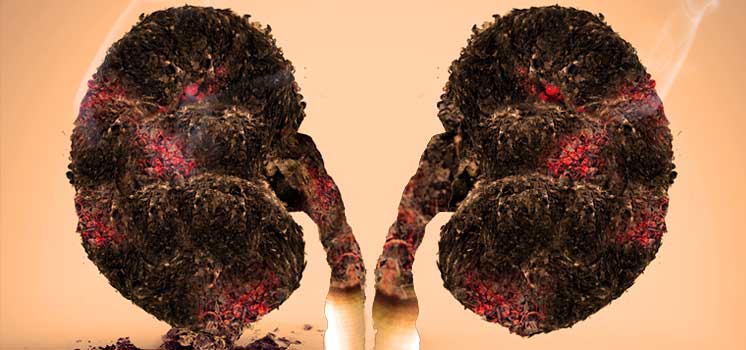Hair loss
Tobacco use weakens the immune system, leaving the body more vulnerable to diseases such as lupus erythematosus, which can cause hair loss, ulcerations in the mouth and rashes on the face, scalp, and hands.
Cataracts
Tobacco use is believed to cause or worsen several eye conditions. Tobacco users have a 40% higher rate of cataracts, a clouding of the eye’s lens that blocks light and may lead to blindness. Tobacco smoke causes cataracts in two ways: by irritating the eyes and by releasing chemicals into the lungs that then travel up the bloodstream to the eyes.
Tobacco use is also associated with age-related macular degeneration, an incurable eye disease caused by the deterioration of the central portion of the retina, known as the macula. The macula is responsible for focusing central vision in the eye and controls our ability to read, drive a car, recognize faces or colours, and see objects in fine detail.
Wrinkling
Tobacco use prematurely ages skin by wearing away proteins that give it elasticity, depleting it of vitamin A and restricting blood flow. Tobacco users' skin is dry, leathery and etched with tiny lines, especially around the lips and eyes.
Hearing loss
Because tobacco use creates plaque on blood vessel walls, decreasing blood flow to the inner ear, tobacco users can lose their hearing earlier than non-users and are more susceptible to hearing loss caused by ear infections or loud noise. Tobacco users are also three times more likely than non-users to get middle ear infections that can lead to further complications, such as meningitis and facial paralysis.
Cancer
More than 40 chemicals in tobacco smoke have been shown to cause cancer. Smokers are some 20 times more likely to develop lung cancer than non-smokers. Smoking causes about 90% of lung cancers in men and 80% in women and according to many studies, the longer one smokes, the greater the risk of developing cancers at several sites, including a two-fold risk of developing cancer of the nasal and paranasal cavities; cancer of the oral cavity (4 to 5 times); two-fold risk of developing cancer of nasopharynx; oro and hypopharynx (4 to 5 times); larynx (10 times); oesophagus (2 to 5 times); stomach (2 times); pancreas (2 to 4 times) and kidney. Some recent studies have also suggested a link between heavy smoking and breast cancer, and smoking cessation substantially reduces the risk for most of the above-mentioned smoking related cancers.
Tooth decay
Tobacco use interferes with the mouth’s chemistry, creating excess plaque, yellowing teeth and contributing to tooth decay. Tobacco users are 1.5 times more likely to lose their teeth.
Emphysema
In addition to lung cancer, tobacco use causes emphysema, a swelling and rupturing of the lung’s air sacs that reduces the lungs’ capacity to take in oxygen and expel carbon dioxide. In extreme cases, a tracheotomy allows patients to breathe. An opening is cut in the windpipe as a ventilator to force air into the lungs.
Chronic bronchitis creates a build-up of pus-filled mucus, resulting in a painful cough and breathing difficulties.
Osteoporosis
Carbon monoxide, the main poisonous gas in car exhaust fumes and tobacco smoke, binds to blood much more readily than oxygen, cutting the oxygen-carrying power of heavy tobacco user’s blood by as much as 15%. As a result, tobacco users’ bones lose density, fracture more easily and take up to 80% longer to heal. Tobacco users may also be more susceptible to back problems: one study shows that industrial workers who use tobacco are five times as likely to experience back pain after an injury.
Heart disease
One out of three deaths in the world is due to cardiovascular diseases. Tobacco use is one of the biggest risk factors for developing cardiovascular diseases. These diseases kill more than a million people a year in developing countries. Tobacco-related cardiovascular diseases kill more than 600 000 people each year in developed countries. Tobacco use makes the heart beat faster, raises blood pressure and increases the risk of hypertension and clogged arteries and eventually causes heart attacks and strokes.
Stomach ulcers
Tobacco use reduces resistance to the bacteria that cause stomach ulcers. It also impairs the stomach’s ability to neutralize acid after a meal, leaving the acid to eat away the stomach lining. Tobacco users’ ulcers are harder to treat and more likely to recur.
Discoloured fingers
The tar in tobacco smoke collects on the fingers and fingernails, staining them a yellowish-brown.
Miscarriage
Tobacco use creates fertility problems for women and complications during pregnancy and childbirth. Tobacco use during pregnancy increases the risk of low weight babies and future ill health consequences. Miscarriage is 2 to 3 times more common in tobacco users, as are stillbirths due to fetal oxygen deprivation and placental abnormalities induced by carbon monoxide and nicotine in tobacco smoke. Sudden infant death syndrome is also associated with tobacco use. In addition, tobacco use can lower estrogen levels causing premature menopause.
Psoriasis
Tobacco users are 2 to 3 times as likely to develop psoriasis, a noncontagious inflammatory skin condition that leaves itchy, oozing red patches all over the body.
Deformed sperm
Tobacco use can deform sperm and damage its DNA, which could cause miscarriage or birth defects. Some studies have found that men who use tobacco have an increased risk of fathering a child who contracts cancer. Tobacco use also diminishes sperm count and reduces the blood flow to the penis, which can cause impotence. Infertility is more common among tobacco users.
Buerger’s disease
Buerger’s disease, also known as thromboangitis obliterans, is an inflammation of arteries, veins and nerves in the legs, principally, leading to restricted blood flow. Left untreated, Buerger’s disease can lead to gangrene (death of body tissue) and amputation of the affected areas.



